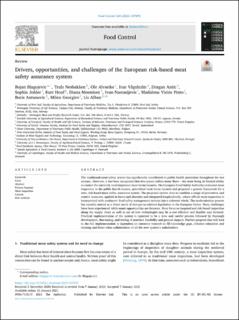| dc.contributor.author | Blagojevic, Bojan | |
| dc.contributor.author | Nesbakken, Truls | |
| dc.contributor.author | Alvseike, Ole | |
| dc.contributor.author | Vågsholm, Ivar | |
| dc.contributor.author | Antic, Dragan | |
| dc.contributor.author | Johler, Sophia | |
| dc.contributor.author | Houf, Kurt | |
| dc.contributor.author | Meemken, Diana | |
| dc.contributor.author | Nastasijevic, Ivan | |
| dc.contributor.author | Vieira Pinto, Madalena | |
| dc.contributor.author | Antunovic, Boris | |
| dc.contributor.author | Georgiev, Milen | |
| dc.contributor.author | Alban, Lis | |
| dc.date.accessioned | 2021-10-01T10:46:07Z | |
| dc.date.available | 2021-10-01T10:46:07Z | |
| dc.date.created | 2021-03-25T10:30:42Z | |
| dc.date.issued | 2021 | |
| dc.identifier.issn | 0956-7135 | |
| dc.identifier.uri | https://hdl.handle.net/11250/2786959 | |
| dc.description.abstract | The traditional meat safety system has significantly contributed to public health protection throughout the last century. However, it has been recognised that this system suffers many flaws – the main being its limited ability to control the currently most important meat-borne hazards. The European Food Safety Authority evaluated meat inspection in the public health context, prioritised meat-borne hazards and proposed a generic framework for a new, risk-based meat safety assurance system. The proposed system aims to combine a range of preventive and control measures, applied at farms and abattoirs and integrated longitudinally, where official meat inspection is incorporated with producers' food safety management systems into a coherent whole. The modernisation process has recently started as a direct result of changes to relevant legislation in the European Union. Many challenges have been experienced while many opportunities are foreseen. More focus on targeted and risk-based inspection along the supply chain as well as use of new technologies may be a cost-effective and feasible way forward. Practical implementation of the system is expected to be a slow and careful process followed by thorough development, fine-tuning, and testing of practical feasibility and general impacts. Further progress that will lead to the full implementation is dependent on intensive research to fill knowledge gaps, enhance education and training and foster close collaboration of all the new system's stakeholders. | |
| dc.language.iso | eng | |
| dc.title | Drivers, opportunities, and challenges of the European risk-based meat safety assurance system | |
| dc.type | Peer reviewed | |
| dc.type | Journal article | |
| dc.description.version | publishedVersion | |
| dc.subject.nsi | VDP::Epidemiologi medisinsk og odontologisk statistikk: 803 | |
| dc.subject.nsi | VDP::Epidemiology, medical and dental statistics: 803 | |
| dc.source.volume | 124 | |
| dc.source.journal | Food Control | |
| dc.identifier.doi | 10.1016/j.foodcont.2021.107870 | |
| dc.identifier.cristin | 1900954 | |
| dc.relation.project | COST (European Cooperation in Science and Technology): CA18105 | |
| cristin.ispublished | true | |
| cristin.fulltext | original | |
| cristin.qualitycode | 1 | |
